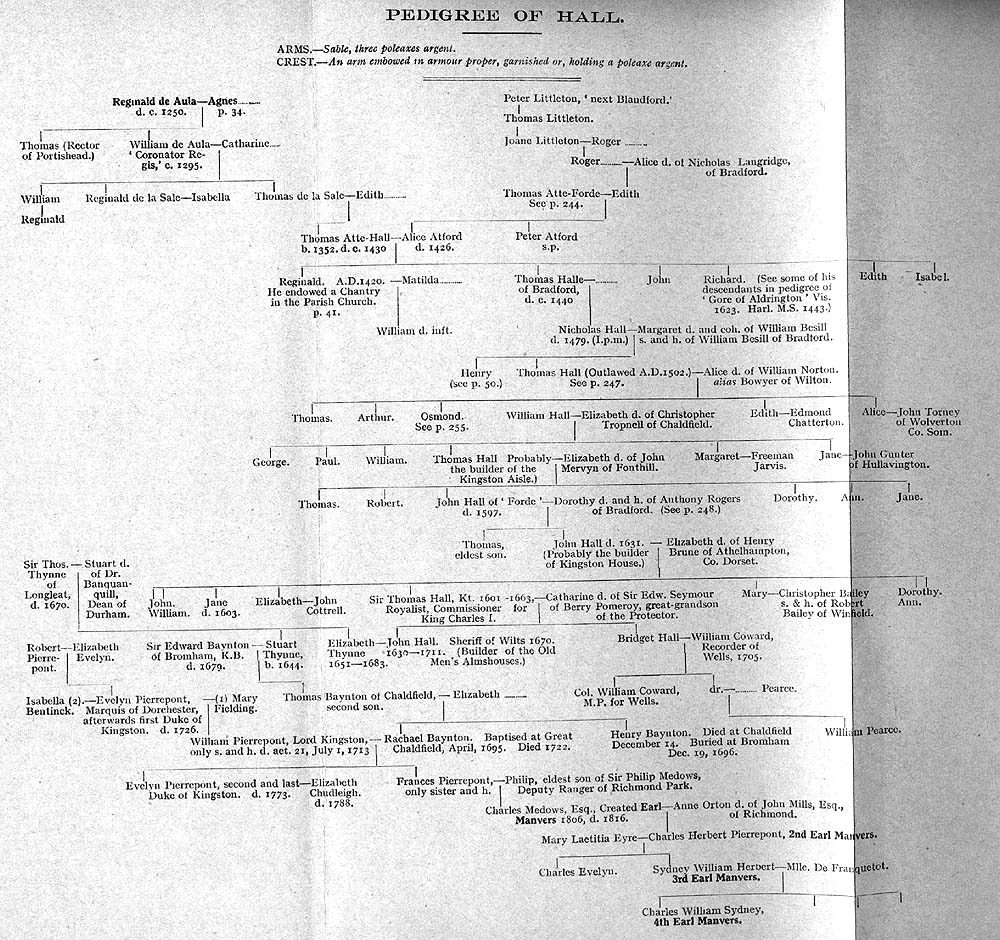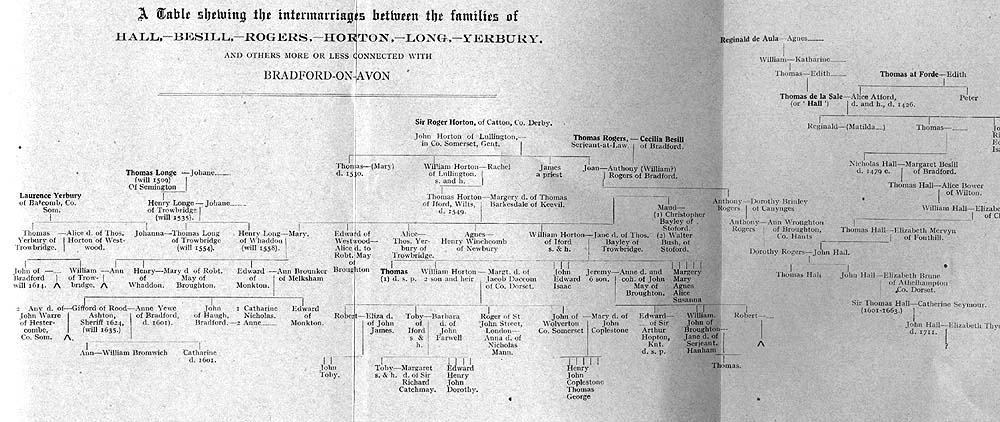The
manor styled HALUS MANOR or the MANOR OF BRADFORD originated in an estate held
of the Abbess of Shaftesbury as part of her manor of Bradford. The family of Hall
was prominent in Bradford from the 14th to the 18th century. William de Aul, his
wife Katherine, and his son Thomas were living there early in the reign of Edward
II. In 1324 Reynold de le Sale of Bradford granted land by a charter in which
he referred to his brother Thomas, Rector of Portis-head (Som.). William, son
of John de Aul, was presented in 1350 to the chapel of Barley in Bradford parish.
Thomas atte Halle, who was alive in 1350 and 1360, was succeeded by his son Thomas
who came of age in I373- The younger Thomas (or a namesake) was living in 1382
and 1408 Alice, relict of Thomas Halle, died in 1427, holding land in Bradford
Leigh and South Wraxall of the Abbess of Shaftesbury. Alice was apparently the
sister and heir of Peter Atford, of Atford. Reynold Halle, who endowed a charity
in the parish church of Bradford in 1420, was probably the eldest son of Alice
and Thomas. This Reynold must have predeceased his mother, for her heir was her
son Thomas Hall. Thomas Hall of Bradford was alive in I450. His son and heir was
Nicholas Hall, who died in 1478 leaving to his son and heir, Henry, lands, houses,
and mills in Bradford held of the Abbess of Shaftesbury. Henry Hall probably died
soon after his father, for he is omitted from the pedigree recorded in the Herald's
Visitation of 1565.The family estates passed to Thomas Hall, probably brother
of Henry, who died in 1515 seized of the Manor of Bradford called Hall's Manor.
Thomas was succeeded by his son William, who died in 1550. Leland, who visited
Bradford about 1542, noted that William Hall lived 'in a pretty stone house at
the east end of the town' and that he was 'a man of £100 lands by the year'."
William's son and heir was Thomas Hall, whose son John died in 1597.l6 In the
course of a lawsuit in 1575 between John Hall and John Stevens of Bradford, butcher,
Stevens stated that 'John Hall, son of Thomas Hall esq. deceased is, and his ancestors
have for a long time been seized of certain water mills and other lands' in the
manor of Bradford, which had been held of the abbey of Shaftesbury and after the
Dissolution of the grantees of the abbey's lands in Bradford by a rent of 7 5/.
a year and suit at the court of the manor. John Hall was succeeded by his son,
also named John, who probably built the present mansion, the Hall. The younger
John died in 1631, leaving a. son and heir, Thomas. Thomas Hall, later knighted,
was a Royalist and compounded for his estates in 1647.He was succeeded in 1663
by his son John, the last of his line, who died in 1711. John Hall's estates passed
to Rachel, daughter of Elizabeth, wife of Thomas Baynton of Little Chalfield.
Mystery surrounds this bequest, but the evidence suggests that Rachel was in fact
the daughter of John Hall by an adulterous union with Elizabeth Baynton, or at
least that Hall himself thought so. A special Act of Parliament was passed to
secure the property to Rachel on her marriage to William Pierrepont, son and heir
of Evelyn Pierrepont (d. 1726) later 1st Duke of Kingston. Rachel's husband died
in 1713 and she herself in 1722 at the age of 27. Her son Evelyn Pierrepont succeeded
his grandfather in 1726 as 2nd Duke of Kingston. During his time the manor, or
parts of it, was let. John Fellows was renting the 'home estate' in 1731 at £80."
At Michaelmas 1768 a three-year lease of the offices and upper court belonging
to the 'Great House' was granted to Scudamore Perry, and in 1770 Richard Whatly
was leasing the 'home estate' for £65.4*."
The 2nd Duke of Kingston
died in 1773, after a bigamous marriage with the notorious Countess of Bristol.
The duke bequeathed all his estates to his 'wife' for her life and although his
relations succeeded in bringing the countess to trial before the House of Lords
for bigamy they were unable to prevent her enjoying the bequest until her death
in 1788. The duke had left no children and by his will his estates then reverted
to Charles Medows, son of his sister Frances,who had married Philip Medows. Charles
took the name of Pierrepont and in 1796 was created Viscount Newark. He became
Earl Manvers in 18o6. In 1802 the Hall, with about 9 acres of land, was sold to
Thomas Divett who allowed it to fall into decay. In 1848 Divett's trustees sold
it to Stephen Moulton, founder of the Bradford rubber firm, in whose family it
has since remained. Earl Manvers has subsequently sold much of his land in the
parish of Bradford. In 1939 Mrs. Moulton was the largest landowner in Bradford.
The
Manvers Collection in Nottingham University Library contains many records of the
administration of the Duke of Kingston's estates in Bradford including an almost
unbroken series of rentals (1722 to 1780) and estate accounts (1726 to 1780) and
a survey of Bradford, Trowbridge, Dauntsey, and Trowle manors (1752).
The manor
house, called the Hall, and sometimes Kingston House, is a well-preserved building
dating from c. 1580 to 16oo.
After the extinction of the dukedom of Kingston
the house fell on evil days, and in the early i8th century was 'let out in separate
apartments to workmen and their families'. In the 'thirties it was occupied by
Samuel Pitman, clothier, formerly of Trowbridge, the father of Sir Isaac Pitman.
Thereafter it was used as a farmhouse until it passed into the hands of the Moulton
family and was restored to its former splendour.
2.The manor of Troll belonged
to the Duke of Kingston in 1731 and appears to have descended with the manor of
Little Trowle until 1829. |

